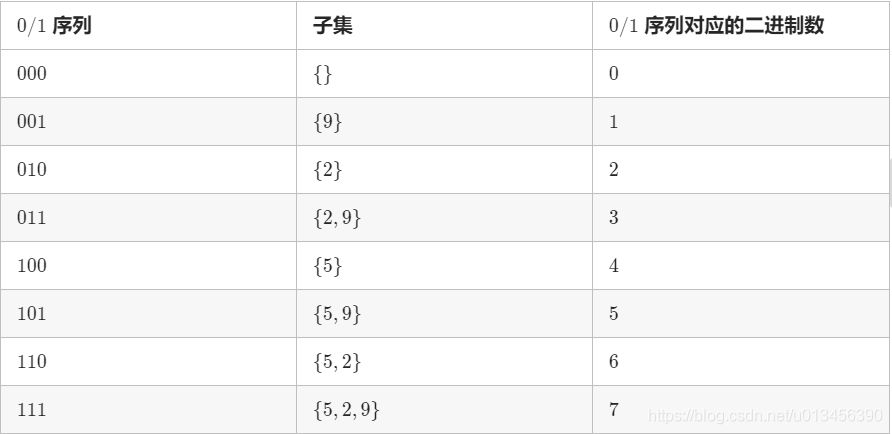LeeCode (bit, dfs) 78_subset
Problem:
Given a set of integer arrays nums without repeated elements, return all possible subsets (power sets) of the array.
Note: The solution set cannot contain duplicate subsets.
Example:
Input: nums = [1,2,3]
Output:
[
[3],
[1],
[2],
[1,2,3],
[1,3],
[2,3],
[1,2 ],
[]
]
Source: LeetCode
Link: https://leetcode-cn.com/problems/subsets
Copyright is owned by LeetCode . For commercial reprints, please contact the official authorization. For non-commercial reprints, please indicate the source.
Problem-solving ideas:
Method 1:
Iteratively implement subset enumeration
- The length of the original sequence is n, and the state ai of the i-th number has two cases:
1. In the subset: use 1 to represent
2. Not in the subset: use 0 to represent - For example, when n=3 and a={5,2,9}:
- It can be found that the binary number corresponding to the 0/1 sequence is exactly from 0 to 2^n-1
- We can enumerate that the binary representation of mask∈[0,2^n−1] is a sequence of 0/1, and we can take numbers from the original set according to this sequence of 0/1. When we have enumerated all 2^n masks, we can also construct all the subsets.
Java code:
import java.util.ArrayList;
import java.util.List;
public class 子集 {
List<Integer> t = new ArrayList<Integer>();
List<List<Integer>> ans = new ArrayList<List<Integer>>();
public List<List<Integer>> subsets(int[] nums) {
int n = nums.length;
for(int mask=0;mask<(1<<n);mask++){
t.clear();
for(int i=0;i<n;i++){
if((mask & (1<<i))!=0){
t.add(nums[i]);
}
}
ans.add(new ArrayList<Integer>(t));
}
return ans;
}
}
It should be noted that:
ans.add(new ArrayList(t)); This line of code cannot be written as ans.add(t);
because if you use ans.add(t); to add data, the data added in ans is shallow copy data ,
Will be changed due to subsequent changes in t, a new instance should be used to create a new memory space for deep copying of the data of ans.
Method 2:
Recursive dfs implements subset enumeration
- The variable cur is the current position, and when the boundary is cur equal to the length of nums, the temporary subset t is added to the result set ans.
- dfs considers two cases:
1.nums[cur] is in the subset
2.nums[cur] is not in the subset
Java code:
import java.util.ArrayList;
import java.util.List;
public class 子集 {
List<Integer> t = new ArrayList<Integer>();
List<List<Integer>> ans = new ArrayList<List<Integer>>();
public List<List<Integer>> subsets(int[] nums) {
dfs(0,nums);
return ans;
}
public void dfs(int cur,int[] nums){
//边界
if(cur==nums.length){
ans.add(new ArrayList<Integer>(t));
return;
}
//两种dfs情况(nums[cur]放入子集 和 nums[cur]不放入子集)
t.add(nums[cur]);
dfs(cur+1,nums);
//回溯
t.remove(t.size()-1);
dfs(cur+1,nums);
}
}
